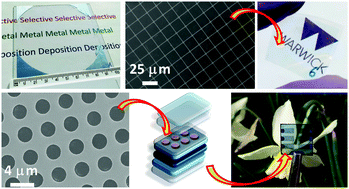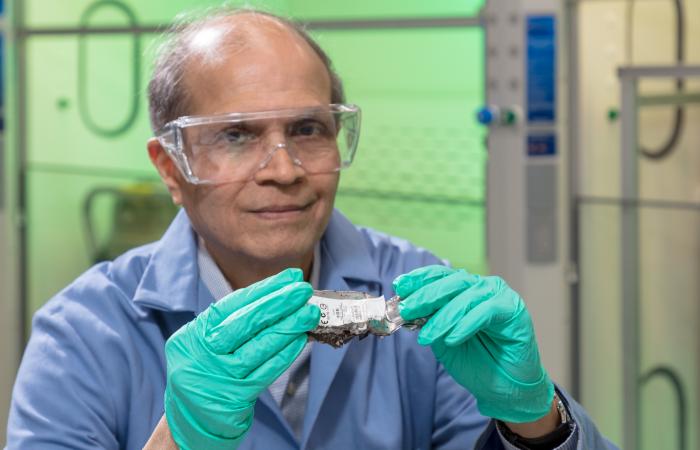(Greener, faster and cheaper way to make patterned metals for solar cells and electronics)
2019/8/14 英国ウォーリック大学
・ ウォーリック大学が、安価な有機フッ素化合物を用いて、有毒化学物質を使用せずに銀と銅のパターンフィルムを作製する方法を開発。
・ 本技術では、金属の堆積を防ぐために、有機フッ素化合物がプリントされた極薄の層を使用するので、金属は必要な個所にのみ堆積し、製造もサステナブルで安価。フレキシブルな太陽電池パネル、次世代センサーや低放射ガラスなどの電極の作製に使用できる。
・ 銀や銅は、電子機器や太陽電池など、現在では最も幅広く使用されている導電体だが、導電ラインに必要なパターンを作製する従来のパターニング手法は、有害な化学物質を使用したエッチングや、高額な金属インクを使用した 3D プリンティングなどで、フィルムから金属を選択的に除去しなくてはならない。
・ 新技術は、金属廃棄物も発生せず、有毒化学物質の使用もなく、製造方法はロール・ツー・ロール方式と互換性があるので、よりサステナブルで安価に銀や銅のパターニングを大量生産できる。
・ 研究チームは、銀と銅は、単純な熱蒸発で析出すると、高濃度にフッ素化された有機化合物の極薄フィルム上には凝縮しないことを発見。熱蒸発の手法はパリッとした袋の内側の薄い金属フィルムの作製に広く使用されており、また、有機フッ素化合物は一般的には焦げ付かないフライパンの主成分として認知されている。
・ 有機フッ素の層が効力を発揮するために必要な量は、1 メートル厚の 100 億分の一でよいことも実証。
・ 新手法では、金属表面が汚染されないまま保たれるので、次世代センサーのような、センシング分子を取り付けるプラットフォームの金属が、汚染されていないパターンフィルムを必要とするものを作製するには、非常に重要な技術。
・ 安価に製造でき、色調整可能で、柔軟性のある軽量な太陽電池のニーズは、昨今の気象変動が提示する様々な環境問題によって高まっており、特に電気自動車や建物用の半透明太陽電池など、従来の硬いシリコン系太陽電池が適当でないアプリケーションへの使用が期待されている。
・ 有機ペロブスカイトや有機ナノ結晶半導体の薄膜系の太陽電池は、このニーズに適合する潜在性を持つが、低コストでフレキシブルな透明電極が必要。研究チームでは、新技術を用いて、銀の上部電極が開口直径 2 ㎛の高密度な配列でパターニングされた半透明有機薄膜太陽電池を作製。これは、有機電子デバイス上に直接設置する量産可能なタイプのものとしては、画期的なレベル。
・ 本研究は、UK Engineering and Physical Sciences Research Council より、115 万英ポンドの資金を得た。
URL: https://warwick.ac.uk/newsandevents/pressreleases/greener_faster_and 3
(関連情報)
Materials Horizons 掲載論文(フルテキスト)
Selective deposition of silver and copper films by condensation coefficient modulation
URL: https://pubs.rsc.org/en/content/articlelanding/2019/mh/c9mh00842j#!divAbstract
<NEDO海外技術情報より>
Abstract
Whilst copper and silver are the conductors of choice for myriad current and emerging applications, patterning these metals is a slow and costly process. We report the remarkable finding that an extremely thin (∼10 nm) printed layer of specific organofluorine compounds enables selective deposition of copper and silver vapour, with metal condensing only where the organofluorine layer is not. This unconventional approach is fast, inexpensive, avoids metal waste and the use of harmful chemical etchants, and leaves the metal surface uncontaminated. We have used this approach to fabricate thin films of these metals with 6 million apertures cm−2 and grids of ∼1 μm lines, through to 10 cm diameter apertures. We have also fabricated semi-transparent organic solar cells in which the top silver electrode is patterned with a dense array of 2 μm diameter apertures, which cannot be achieved by any other scalable means directly on an organic electronic device.




